Rebalancing Growth in Asia
Finance & Development, December 2009, Volume 46, Number 4
Asian emerging markets can improve their economic welfare by rebalancing growth toward domestic demand
WITH the increasing importance of Asian emerging markets in the world economy, rebalancing growth in developing Asia toward more reliance on domestic demand and less on exports is an important component of the global effort to stabilize world financial and economic systems.
Asia’s export-oriented growth strategy played a role in the global imbalances that have characterized the international economy in recent years and played some role—though how much is hotly debated—in contributing to the global economic crisis.
Global imbalances—with large current account deficits in the United States and a few other advanced economies and big current account surpluses in oil-exporting countries and in emerging Asian markets, especially China—provided cheap money that worsened the root problems of weak regulatory systems and regulatory failures in the United States and other advanced economies. These imbalances remain troubling because if a disorderly adjustment does take place, through a sharp fall in the value of the dollar or a prolonged contraction in economic activity in industrial countries, it will be very costly and disruptive to the world economy.
Not only would a reduction of the imbalances in emerging Asia be helpful to the global economy, rebalancing may offer advantages to other countries in the region as well by making their high growth rates more durable, translating into more benefits for their citizens.
If rebalancing is a goal, the first question is how to evaluate the “balance” of an economy in terms of reliance on domestic versus foreign demand and also in terms of the composition of domestic demand. There is no definitive answer, but my approach is to evaluate growth patterns in the major Asian emerging markets—China, India, Indonesia, Korea, and Thailand—and then to analyze these patterns to see how this growth improves the economic welfare of the average household in these economies.
Growth patterns
One way to characterize the balance in a country’s growth is to look at the evolution of the major components of its national output—private consumption, government consumption, investment, net exports—and employment.
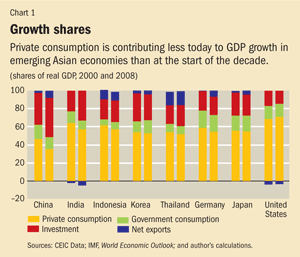 Evolution of national saving rates
Evolution of national saving rates
Over the past decade, the share of private consumption in gross domestic product (GDP) has fallen in key emerging Asian economies and in the largest advanced economies, with the notable exception of the United States (see Chart 1). In China, there was a dramatic drop from an already low 46 percent in 2000 to 35 percent in 2008. By contrast, the shares of both investment and net exports rose markedly in China—by about 8 and 6 percentage points, respectively—between 2000 and 2008. There was also a significant decline in India’s private consumption relative to GDP—from 64 percent in 2000 to 57 percent in 2008, with investment taking up the slack.
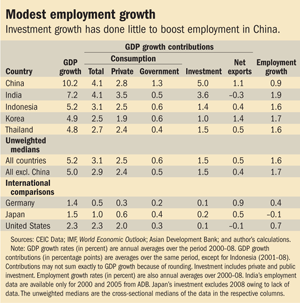 External (im)balances
External (im)balances
When we look at average GDP growth rates for the same countries, private consumption accounts for under one-third of China’s GDP growth, less than any other economy in the sample (see table). Investment growth made a major contribution to overall growth rates in both China and India—accounting for nearly half of overall GDP growth. In China, investment growth has been the dominant source of GDP growth.
After evaluating private consumption and investment, it is important to assess how dependent a country is on external trade for growth. Even if a country has a high level of exports relative to GDP, it could also import substantially, meaning that net exports (exports less imports) contributed little to bottom-line GDP growth. China is popularly characterized as relying on export-led growth, but the direct contribution of net exports to GDP growth amounted to only 1.1 percentage points a year over 2000–08, just one-tenth of overall GDP growth. However, in sheer volume, China’s trade surplus of $295 billion in 2008 (6.8 percent of GDP) dominates aggregate Asian trade (excluding Japan) with the rest of the world.
The Chinese growth model, which has relied to a great extent on investment growth, has resulted in limited employment growth—barely 1 percent a year, or about one-tenth the rate of output growth during this decade (see table)—which is odd for an economy with a huge labor force and significant underemployment. Even though this may reflect high productivity growth, the low rate of employment growth is clearly of concern even to the Chinese government because it has implications for economic and social stability. Employment growth has also been modest in other Asian economies.
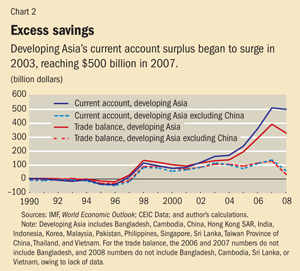
Domestic and global imbalances are connected through the current account—or the difference between national savings and investment. Chart 2 shows the overall current account balance for developing Asia between 1990 and 2008. The total excess savings of the Asian region amounted to about $100 billion in the early 2000s, then began to surge in 2003.
Nearly all of the growth in excess savings was from China. Excess savings from the other countries was steady at about $100 billion through 2007–08. The aggregate current account balance, including China, jumped to $500 billion by 2007–08, driven by massive Chinese current account surpluses, which hit $440 billion in 2008. Indeed, China’s national savings and current account surpluses dominate the region’s savings-investment balances. China accounts for just under half of GDP in Asia (excluding Japan), but accounts for nearly 90 percent of the region’s current account surplus. The trade surplus, again dominated by China, is the main determinant of the region’s current account surplus.
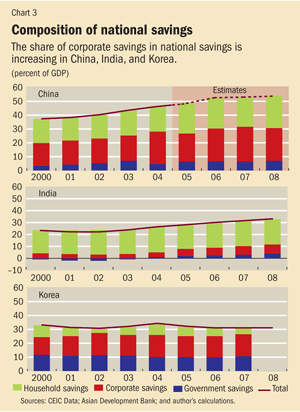
To explore saving in more detail, we look at the evolution of gross national saving rates and the composition of savings in China, India, and Korea. These three economies account for about three-quarters of GDP in Asia (excluding Japan). And all three have experienced an increase in corporate savings (see Chart 3). In China, the share of corporate savings has risen markedly, accounting for almost half of national savings by 2007–08. Interestingly, in India, household savings have remained the dominant source of national savings, amounting to about 20 percent of GDP since the early 2000s, whereas corporate savings have become increasingly important in recent years. In Korea, household savings as a ratio of GDP have fallen since the late 1990s, driving down overall national savings slightly.
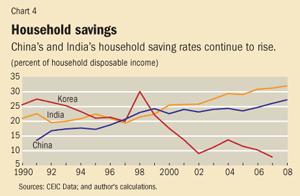
Looking at savings relative to household disposable income offers a different perspective on household savings. Chart 4 shows that China’s household saving rate rose markedly during the second half of the 1990s and continued to increase during the high-growth years of this decade, reaching 28 percent of household disposable income in 2008. The household saving rate in India has risen sharply over the past decade, from 20 percent of disposable income in 1998 to 32 percent in 2008. Indeed, India now seems to have the highest household saving rate among the Asian economies for which data are available. By contrast, the household saving rate in Korea has fallen considerably, from nearly 30 percent in the late 1990s to 7 percent in 2007.
Both the evolution of overall saving rates and the sources of national savings vary substantially across countries. China accounted for about 62 percent of gross national savings in all of Asia (excluding Japan) in 2008. In terms of sheer magnitude, the sharp increase in corporate savings and the evolution of Chinese savings clearly both play big roles in influencing overall saving patterns in Asia (Prasad, 2009b).
Corporate savings
Corporate savings reflect retained earnings, which in turn depend on the profitability of firms. Lin (2009) argues that China’s high level of corporate savings is partly thanks to a financial structure dominated by state-owned banks and an equity market with restricted entry, both of which favor large firms. Similarly, China’s repressed financial system provides cheap capital (low real interest rates) to large state-owned firms. Massive state subsidies combined with administrative monopolies have led to high profitability in some sectors, with the boom years until mid-2008 generating rising profits. In a fast-growing economy, retaining and reinvesting profits is clearly an attractive proposition when firms face a very low opportunity cost of funds.
China’s underdeveloped financial system and dividend policies for its state-owned firms also help explain the high level of retained earnings among profitable Chinese firms. Until recently, state-owned enterprises were not required to pay dividends to their shareholders or to the state. Moreover, the lack of alternative financing mechanisms such as a deep corporate bond market has led firms to retain their earnings to finance future investment projects.
There are clearly links between different imbalances. Government subsidies for energy and land, as well as cheap capital provided by the state-owned banking system, have created incentives for massive investment in China. This helps explain the declining share of labor income in national income—down 8 percentage points over the past decade—and low employment growth. Repressed low interest rates on bank deposits also give firms an incentive to recycle their retained earnings into further investments, including even marginally productive projects. An inefficient financial system can create a variety of imbalances that hold down employment and household income growth and discourage consumption growth (Prasad, 2009a).
What drives household saving in China?
Household saving in China accounts for two-thirds of total household saving in Asia. Analyzing the factors that drive the rising Chinese household saving rate is a first step in devising policy measures to stoke private consumption growth.
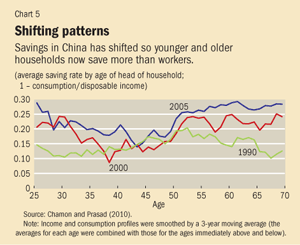
In joint work with Marcos Chamon (2010), I use data from a sample of urban households, which account for about two-thirds of total income, to study the determinants of rising household saving in China. In 1990, the saving rate initially increases with age, peaks at around age 50, and then declines (see Chart 5). This is the pattern predicted by standard economic models. Young workers borrow against their future income; workers have the highest saving rates when their incomes are highest, in the latter stages of their careers; and retirees start drawing down their savings when they stop working.
By 2005, saving rates in China increased for all age groups. More interestingly, the age profile of saving shifts to an unusual pattern, with younger and older households having relatively high saving rates. A careful statistical analysis confirms this pattern even after controlling for other factors such as shifting demographic trends. We find that these patterns are best explained by the rising private burden of expenditures on housing, education, and health care. For instance, health expenditure–related risks largely explain the dramatic increase in saving rates among elderly households. As the population ages and income levels rise, the demand for health care is growing and is not being met by the state-financed health care system.
These effects and precautionary motives may have been amplified by financial underdevelopment, as reflected in constraints on borrowing against future income and low returns on financial assets. In a fast-growing economy where the desired consumption bundle shifts toward big-ticket durable goods such as cars and houses, inability to borrow against future income could lead to households saving more to self-finance their purchases. Lack of diversification opportunities for financial assets could cause households to save more for precautionary purposes. These factors are exacerbated when greater macroeconomic and household-level uncertainty—as a result of enterprise restructuring and other aspects of the transition to a market economy—increases precautionary saving.
How to address imbalances
This analysis points to steps that could promote domestic demand growth (especially private consumption growth), reduce dependence on external demand, raise employment growth, and improve overall economic welfare in Asian economies, particularly China.
- Social safety net. Increasing spending on the social safety net and other government insurance mechanisms could help reduce precautionary motives for saving. Better provision and delivery of health care would reduce the need for older citizens to save and self-insure. This is increasingly relevant with lengthening life spans, increasing health care costs, and rising dependency ratios of older people to working-age people.
- Financial market development. A broader array of financial markets—including insurance, corporate bond markets, and a variety of “plain vanilla” derivatives markets such as currency futures—would provide more instruments for saving, borrowing, and hedging risk. It would also allow for diversification across different types of income (labor versus financial) and different types of assets. And more channels for raising funds means firms could rely less on retained earnings for financing their investment.
- Improving financial system efficiency. A better-functioning financial system could channel capital into more productive uses, providing credit to corporations and entrepreneurs and promoting entrepreneurial activity. This would raise employment if the shift in incentives increased the amount of bank credit available to small and medium-sized private enterprises that are dynamic and serve as engines of employment growth.
- Financial inclusion. An important aspect of financial development is to give a broader swath of the population, especially in rural areas, access to the formal financial system, including banking, insurance, and securities markets. This would increase returns on savings and reduce incentives for households to save more to self-insure against health and other risks. It would also give small-scale entrepreneurs the opportunity to raise funds without having to create and use their own savings.
- Macro policies. In some countries with tightly managed exchange rates, a more flexible exchange rate regime that allows the exchange rate to respond to differences in productivity relative to trading partner countries could generate positive wealth effects. A higher exchange rate value would make foreign goods, including consumer and investment goods, cheaper in domestic currency terms. This would encourage private consumption and reduce reliance on foreign demand. A more flexible exchange rate, by allowing more independent monetary policy, could also improve macroeconomic stability, which in turn would have a favorable effect on both output and employment growth (Prasad and Rajan, 2006).
No magic bullet
There is no magic bullet for countries trying to rebalance growth away from excessive dependence on exports and/or investment. A number of complementary policy measures can help build momentum toward the objective of more balanced growth driven by domestic demand. This will benefit Asian economies and at the same time promote the stability of the international financial system.
References
Chamon, Marcos, and Eswar Prasad, 2010, “Why Are Saving Rates of Urban Households in China Rising?” American Economic Journal: Macroeconomics (January).
Lin, Justin, 2009, “Paradigm Shift on Both Sides of the Global Imbalance,” presentation at the Brookings-Caijing Conference in Washington, D.C., January.
Prasad, Eswar, 2009a,“Is the Chinese Growth Miracle Built to Last?” China Economic Review, Vol. 20, No. 3, pp. 103–23.
———, 2009b, “Rebalancing Growth in Asia,” NBER Working Paper 15169 (Cambridge, Massachusetts: National Bureau of Economic Research).
———, and Raghuram Rajan, 2006, “Modernizing China’s Growth Paradigm,” American Economic Review, Vol. 96, No. 2, pp. 331–36.
Eswar Prasad is the Tolani Senior Professor of Trade Policy at Cornell University, a Senior Fellow and New Century Chair in International Economics at the Brookings Institution, and a Research Associate at the National Bureau of Economic Research.


